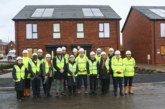 Matthew Warburton, Policy Advisor at the Association of Retained Council Housing (ARCH), considers what we can expect from the next government in terms of housing policy and dissects the proposals of the three main opposition parties.
Matthew Warburton, Policy Advisor at the Association of Retained Council Housing (ARCH), considers what we can expect from the next government in terms of housing policy and dissects the proposals of the three main opposition parties.
By early 2025 we will have a new Government, and current polling suggests it is unlikely to be Conservative-led. Labour is currently on track for a substantial majority, but given the volatility of current politics it would be foolish to rule out the possibility of another hung parliament. What policies can we expect from a new government for housing?
There is a perhaps surprising amount of common ground among the main English opposition parties on broad aims and policies for council housing; most of the differences are on matters of detail. Labour, Lib Dems and Greens all agree on the need to substantially increase the supply of housing for social, or genuinely affordable rent.
Annual target
Labour is reluctant to commit to an annual target but the Lib Dems and Greens both argue for 150,000 new social homes a year to address housing need and the homelessness crisis. For the Greens, increasing social housing supply is seen as more important than hitting the current Government target of 300,000 new homes a year across all tenures. The housing policy paper presented to the Lib Dem conference took the same view but was amended from the conference floor to reinstate an overall target (for the UK as a whole) of 380,000 homes. Labour, in contrast, has committed to 1.5 million new homes over the next parliament but has not said just how many of them will be for social rent.
The parties do not agree on the future of the Right to Buy. Only the Greens would abolish it. Labour proposes to review and reduce discounts and strengthen covenants restricting early resale. The Lib Dems propose giving local authorities freedom to vary discounts according to local conditions and, in extreme cases, to suspend RTB altogether.
Nor is there agreement on where new homes should be built. Labour proposes 10 New Towns, including development on parts of the Green Belt. The Lib Dems go for 10 Garden Cities, without saying whether the Green Belts would be affected. The Greens argue that Green Belt boundaries should be kept under review but with no reduction in the overall acreage. Reactions to Labour’s New Towns plans have argued that it will focus development on the South and East, aggravating the North-South divide that levelling-up was supposed to address.
Social housing quality
Labour, Lib Dems and Greens all propose big increases in investment in insulation and other measures to improve the energy efficiency of homes in all sectors. Interestingly, there is no mention of programmes specifically for social housing like the current Social Housing Decarbonisation Fund; the emphasis is on an area-based cross-tenure focus, with both Labour and Lib Dems mentioning “street by street” approached co-ordinated by local authorities, with the Lib Dems wanting to build on the experience of the General Improvement Areas of the 1970s.
Less is said about other aspects of social housing quality. Labour says only that it will “seek to improve the quality and safety of social housing”; the Lib Dems commit to complete the review of the Decent Homes Standard and implement the new standard (for social housing) by 2030. The new regulatory system for social housing is nowhere explicitly mentioned. Nor is there any acknowledgement that the costs of raising the quality of social housing, financing decent homes, building safety and better thermal efficiency may stretch many council HRAs to breaking point without a satisfactory long-term settlement on rents. These are matters on which councils will want an early conversation with any new Minister for Housing.
Header image: ©Duncan Andison/AdobeStock










